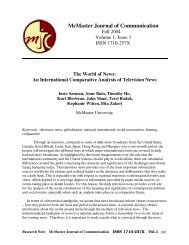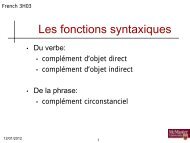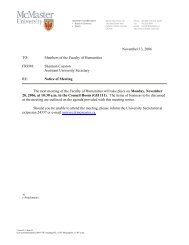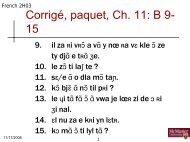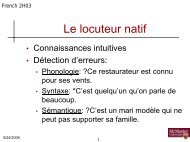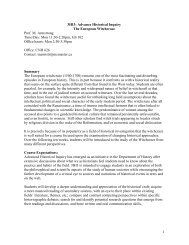The Syntax of Givenness Ivona Kucerová
The Syntax of Givenness Ivona Kucerová
The Syntax of Givenness Ivona Kucerová
Create successful ePaper yourself
Turn your PDF publications into a flip-book with our unique Google optimized e-Paper software.
(4) Derivation <strong>of</strong> basic word order <strong>of</strong> unergatives:<br />
TP<br />
T<br />
vP<br />
subject<br />
vP<br />
v-V<br />
VP<br />
t V<br />
(5) Derivation <strong>of</strong> basic word order <strong>of</strong> unaccusatives:<br />
TP<br />
T<br />
vP<br />
v-V<br />
VP<br />
t V<br />
subject<br />
I argue that there is nothing special about unaccusatives and unergatives with respect<br />
to G-movement. <strong>The</strong> leftmost element can also be interpreted as given, without any word<br />
order change, as seen in (6) and (7).<br />
(6) a. What did Mary do?<br />
b. Marie || tancovala<br />
Marie danced<br />
’Marie danced.’<br />
(7) a. What arrived?<br />
b. Přijel<br />
arrived<br />
|| vlak<br />
train<br />
‘A train arrived.’<br />
Furthermore, as the examples in (8) and (9) show, if the word order is reversed, the all<br />
new interpretation is not available anymore and the leftmost element must be interpreted as<br />
given.<br />
(8) a. What happened?<br />
b. #[Tancovala Marie] New<br />
danced Marie<br />
’Marie danced.’<br />
c. Who danced?<br />
d. Tancovala || Marie<br />
danced Marie<br />
’Marie danced.’<br />
‘<strong>The</strong>re are various opinions about history.’<br />
44







